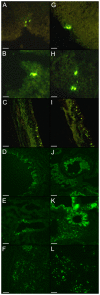Comparative pathogenesis of an avian H5N2 and a swine H1N1 influenza virus in pigs
- PMID: 19684857
- PMCID: PMC2722722
- DOI: 10.1371/journal.pone.0006662
Comparative pathogenesis of an avian H5N2 and a swine H1N1 influenza virus in pigs
Abstract
Pigs are considered intermediate hosts for the transmission of avian influenza viruses (AIVs) to humans but the basic organ pathogenesis of AIVs in pigs has been barely studied. We have used 42 four-week-old influenza naive pigs and two different inoculation routes (intranasal and intratracheal) to compare the pathogenesis of a low pathogenic (LP) H5N2 AIV with that of an H1N1 swine influenza virus. The respiratory tract and selected extra-respiratory tissues were examined for virus replication by titration, immunofluorescence and RT-PCR throughout the course of infection. Both viruses caused a productive infection of the entire respiratory tract and epithelial cells in the lungs were the major target. Compared to the swine virus, the AIV produced lower virus titers and fewer antigen positive cells at all levels of the respiratory tract. The respiratory part of the nasal mucosa in particular showed only rare AIV positive cells and this was associated with reduced nasal shedding of the avian compared to the swine virus. The titers and distribution of the AIV varied extremely between individual pigs and were strongly affected by the route of inoculation. Gross lung lesions and clinical signs were milder with the avian than with the swine virus, corresponding with lower viral loads in the lungs. The brainstem was the single extra-respiratory tissue found positive for virus and viral RNA with both viruses. Our data do not reject the theory of the pig as an intermediate host for AIVs, but they suggest that AIVs need to undergo genetic changes to establish full replication potential in pigs. From a biomedical perspective, experimental LP H5 AIV infection of pigs may be useful to examine heterologous protection provided by H5 vaccines or other immunization strategies, as well as for further studies on the molecular pathogenesis and neurotropism of AIVs in mammals.
Conflict of interest statement
Figures


Similar articles
-
Prior infection with an H1N1 swine influenza virus partially protects pigs against a low pathogenic H5N1 avian influenza virus.Vaccine. 2009 Oct 23;27(45):6330-9. doi: 10.1016/j.vaccine.2009.03.021. Vaccine. 2009. PMID: 19840669
-
Absence of clinical disease and contact transmission of HPAI H5NX clade 2.3.4.4 from North America in experimentally infected pigs.Influenza Other Respir Viruses. 2017 Sep;11(5):464-470. doi: 10.1111/irv.12463. Epub 2017 Sep 2. Influenza Other Respir Viruses. 2017. PMID: 28688206 Free PMC article.
-
Efficient transmission of swine-adapted but not wholly avian influenza viruses among pigs and from pigs to ferrets.J Infect Dis. 2009 Dec 15;200(12):1884-92. doi: 10.1086/648475. J Infect Dis. 2009. PMID: 19919303
-
[Swine influenza virus: evolution mechanism and epidemic characterization--a review].Wei Sheng Wu Xue Bao. 2009 Sep;49(9):1138-45. Wei Sheng Wu Xue Bao. 2009. PMID: 20030049 Review. Chinese.
-
Isolation and genetic characterization of avian-like H1N1 and novel ressortant H1N2 influenza viruses from pigs in China.Biochem Biophys Res Commun. 2009 Aug 21;386(2):278-83. doi: 10.1016/j.bbrc.2009.05.056. Epub 2009 May 19. Biochem Biophys Res Commun. 2009. PMID: 19460353 Review.
Cited by
-
Co-infection of classic swine H1N1 influenza virus in pigs persistently infected with porcine rubulavirus.Vet Microbiol. 2016 Feb 29;184:31-9. doi: 10.1016/j.vetmic.2016.01.005. Epub 2016 Jan 7. Vet Microbiol. 2016. PMID: 26854342 Free PMC article.
-
Effect of serial pig passages on the adaptation of an avian H9N2 influenza virus to swine.PLoS One. 2017 Apr 6;12(4):e0175267. doi: 10.1371/journal.pone.0175267. eCollection 2017. PLoS One. 2017. PMID: 28384328 Free PMC article.
-
Genetic Adaptation of Influenza A Viruses in Domestic Animals and Their Potential Role in Interspecies Transmission: A Literature Review.Ecohealth. 2016 Mar;13(1):171-98. doi: 10.1007/s10393-014-1004-1. Epub 2015 Jan 29. Ecohealth. 2016. PMID: 25630935 Review.
-
Antiviral responses by Swine primary bronchoepithelial cells are limited compared to human bronchoepithelial cells following influenza virus infection.PLoS One. 2013 Jul 10;8(7):e70251. doi: 10.1371/journal.pone.0070251. Print 2013. PLoS One. 2013. PMID: 23875024 Free PMC article.
-
Comparative distribution of human and avian type sialic acid influenza receptors in the pig.BMC Vet Res. 2010 Jan 27;6:4. doi: 10.1186/1746-6148-6-4. BMC Vet Res. 2010. PMID: 20105300 Free PMC article.
References
-
- Van Reeth K. Avian and swine influenza viruses: our current understanding of the zoonotic risk. Vet Res. 2007;38:243–260. - PubMed
Publication types
MeSH terms
Substances
Grants and funding
LinkOut - more resources
Full Text Sources

